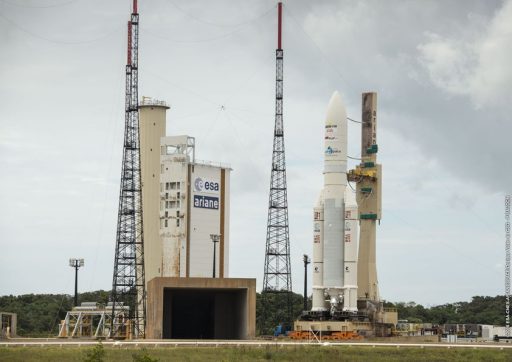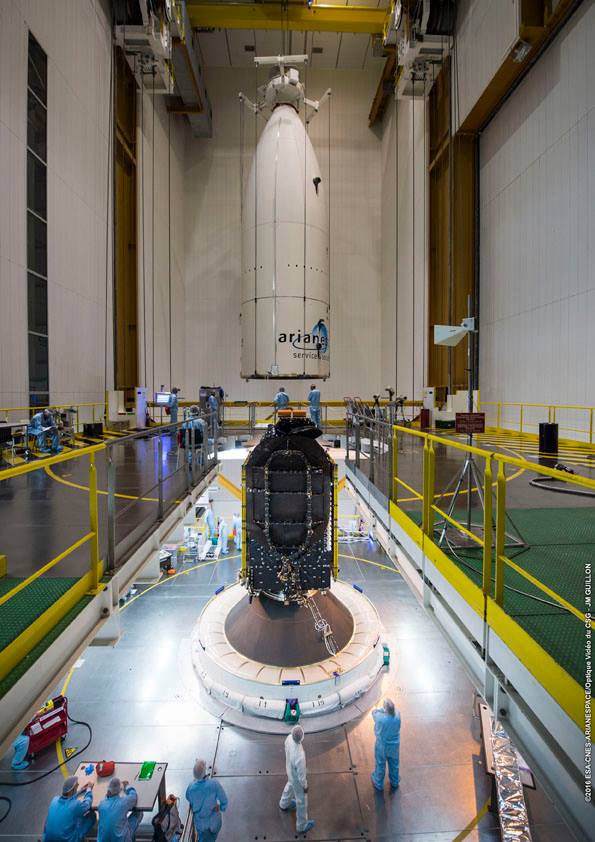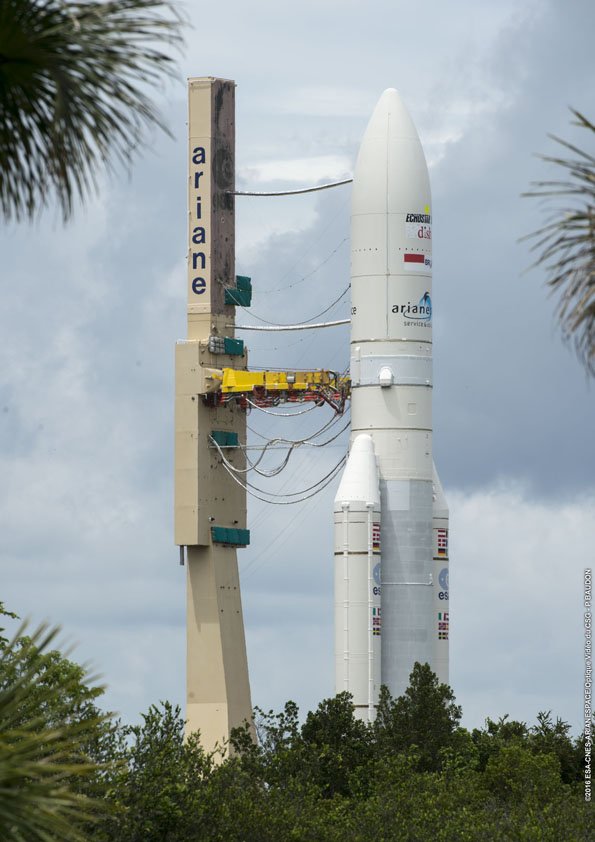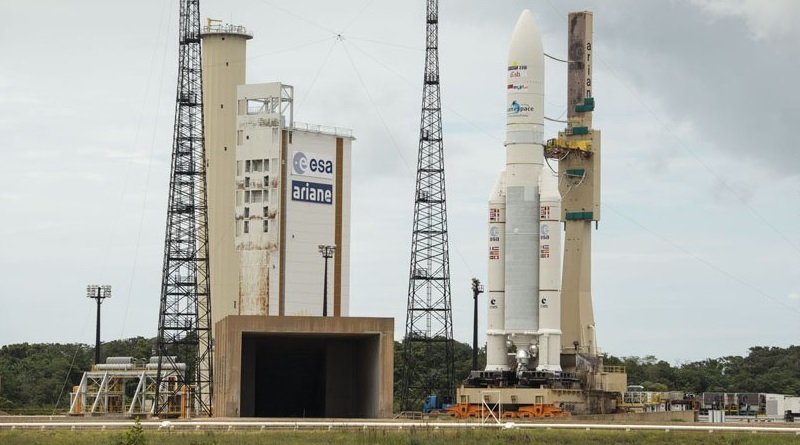Ariane 5 rolls to French Guiana Launch Pad for Dual-Payload Delivery Friday

Europe’s Ariane 5 workhorse was moved to its French Guiana launch pad on Thursday to set the stage for liftoff during a 70-minute launch window opening at 20:30 UTC on Friday.
Hidden under Ariane’s payload fairing is a pair of communications satellites built by Space Systems Loral, setting a new record for the heaviest payload delivered to a Geostationary Transfer Orbit by Ariane 5. EchoStar 18, a heavy commercial communications satellite, and BRIsat, the word’s first dedicated banking satellite, have a combined mass of 10,730 Kilograms (including their payload adapters holding them in position atop the two-stage rocket.)
The previous record for Ariane 5 was set in February 2013 when the launcher lifted 10,500 Kilograms to a highly elliptical transfer orbit.
The VA230 mission had to be postponed from a June 8 target due to a problem that occurred ahead of the planned rollout of the 55-meter tall rocket. The anomaly was associated with a fluid connector between the cryogenic upper stage and the launch table – a condition similar to a problem encountered during the VA222 campaign in April 2015 which also pushed the launch back eight days to facilitate a replacement of the faulty component.

Arianespace managers and payload teams went through a Delta Launch Readiness Review on Tuesday to assess the hardware replacement and look at the readiness of all systems needed to support the mission, on the Ariane 5 vehicle and the ground. With no issues present, Ariane 5 was once again cleared to enter launch operations.
Rollout was again delayed on Wednesday when a different connector in the upper portion of the vehicle caused trouble, leading to a 24-hour delay of the launch.
Ariane 5 – sitting atop one of two operational Mobile Launch Tables – emerged from its Final Assembly Building on Thursday and completed a short rail-ride to the ELA-3 launch site. Once positioned atop the pad, the vehicle was connected to commodity lines and engineers began the process of closing out the vehicle and launch facility to set up for countdown operations on Thursday.
The countdown will formally pick up eleven and a half hours prior to the opening of the launch window when final preparatory steps at the launch pad are initiated to prepare the Ariane 5 rocket for propellant loading and button up all ground systems. The rocket is powered up at T-7.5 hours for a set of checkouts to confirm the vehicle is ready for launch prior to commencing tanking operations.

Propellant Loading kicks off at T-5 hours with a chilldown of ground systems and tanks before Liquid Oxygen and Liquid Hydrogen can be pumped into the EPC Cryo Core and the ESC Second Stage. The two-hour tanking sequence will fill the vehicle with 174 metric tons of cryogenic propellants which will be kept topped up at flight level throughout the countdown.
A repetition of systems checks occurs inside L-90 minutes and the two satellites switch to internal power half and hour before liftoff with final Status Checks at T-10 minutes to clear the vehicle for the Synchronized Sequence. The 7-minute computer controlled sequence will take the Ariane 5 through the reconfiguration of its flight control system, the pressurization of tanks, transfer to battery power and activation of pyrotechnic systems.
When clocks hit zero, the Vulcain 2 engine will ignite to soar to a launch thrust of 960 Kilonewtons with seven seconds of engine monitoring before the twin Solid Rocket Boosters are ignited and Ariane soars off from its equatorial launch pad.
Delivering 92% of Ariane’s total liftoff thrust, the boosters will quickly push the vehicle through the sound barrier with Mach 1 expected just 49 seconds after liftoff followed 20 seconds later by Maximum Dynamic Pressure.

The twin boosters will burn out at T+2 minutes and 21 seconds before separating from the Ariane 5 launch vehicle. Powered by the Vulcain 2 engine alone, the vehicle will depart the dense atmosphere for the separation of the Payload Fairing three minutes and 25 seconds into the flight.
The first stage will shut down eight minutes and 54 seconds into the mission with the separation of the stage six seconds later and followed by the ignition of the HM-7B engine of the second stage on a burn of 16 minutes and 27 seconds.
The mission is targeting an orbit of 250 by 35,766 Kilometers at an inclination of 6.0 degrees. EchoStar 18 is set for separation from the Ariane 5 at T+29:20. BRIsat – riding in the lower payload berth – will be revealed 35 minutes into the flight when the Sylda payload adapter is jettisoned to clear the path for the spacecraft, set for release seven minutes later.
EchoStar 18 is operated by Dish Network Corporation (EchoStar) to deliver broadcasting services to the Continental United States, Alaska, Hawaii, Puerto Rico and Cuba to a customer base of nearly 14 million. The spacecraft sports 78 Ku-Band transponders and exclusively uses spot-beam technology for the transmission of the communications carriers to create a system with a high-degree of flexibility.
BRIsat is the first dedicated satellite for banking purposes, operated by Bank Rakyat Indonesia to provide reliable communications services to BRI’s 11,000 bank branches across the Indonesian Islands as well as connecting 237,000 electronic channel outlets. The satellite carries 9 Ku-Band and 36 C-Band transponders utilized by BRI as well as the Indonesian government.

